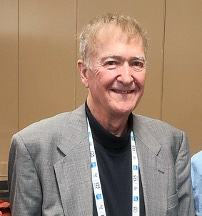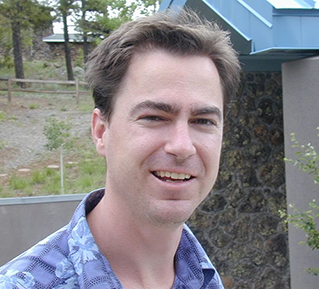The Fizeau and Michelson Prizes were awarded to Drs. Steve Ridgway and Peter Tuthill, respectively, at the SPIE conference in Yokohama, Japan, on June 21, 2024, in recognition of their scientific contributions to the field of astronomical interferometry.
 Yokohama, Japan—Eric Lagadec and Florentin Millour of the Observatoire de la Côte d'Azur (OCA) awarded the Fizeau Prize to Steve Ridgway of NSF's NOIRlab for his lifelong work on long-baseline interferometry. “Participating in a field from its beginning through the exponential growth phase is like taking a constantly reimagined road trip,” says Ridgway. He is an extremely prolific researcher and has contributed to many instruments and observatories. His work covers lunar occultations, speckle interferometry, double Fourier interferometers, and he has also contributed to the construction of several facilities, including IRMA, IOTA, and the CHARA and Keck interferometers. Ridgway has also contributed to the OHANA and FLUOR projects, and has contributed to important decisions, notably the decision to proceed with the interferometric mode of the VLTI, and the commencement of openly available time of CHARA. He also continues his work with contributions on quantum methods applied to optical interferometry.
Yokohama, Japan—Eric Lagadec and Florentin Millour of the Observatoire de la Côte d'Azur (OCA) awarded the Fizeau Prize to Steve Ridgway of NSF's NOIRlab for his lifelong work on long-baseline interferometry. “Participating in a field from its beginning through the exponential growth phase is like taking a constantly reimagined road trip,” says Ridgway. He is an extremely prolific researcher and has contributed to many instruments and observatories. His work covers lunar occultations, speckle interferometry, double Fourier interferometers, and he has also contributed to the construction of several facilities, including IRMA, IOTA, and the CHARA and Keck interferometers. Ridgway has also contributed to the OHANA and FLUOR projects, and has contributed to important decisions, notably the decision to proceed with the interferometric mode of the VLTI, and the commencement of openly available time of CHARA. He also continues his work with contributions on quantum methods applied to optical interferometry.
 Dr. Gerard van Belle of Lowell Observatory awarded the Michelson Prize Dr. Peter Tuthill of the University of Sydney at the same event. “I'm so humbled to be awarded this prize in honor of Albert Michelson, a titan of physics who single-handedly invented the field I work in,” says Tuthill. “The work I have been recognized for here was all done collaboratively, and I have been incredibly lucky to work with amazing students and young scientists throughout my career." Tuthill has contributed to theoretical work, instrumentation, science and student training in the field of interferometry. He has notably participated in many facilities, from COAST to CHARA and the VLTI ; the establishment of aperture masking as the reference technique for high resolution at single aperture ; developments in photonics and space interferometry ; and a wide range of scientific results. Tuthill supported many students in interferometry whom have had a strong and lasting impact on this scientific field.
Dr. Gerard van Belle of Lowell Observatory awarded the Michelson Prize Dr. Peter Tuthill of the University of Sydney at the same event. “I'm so humbled to be awarded this prize in honor of Albert Michelson, a titan of physics who single-handedly invented the field I work in,” says Tuthill. “The work I have been recognized for here was all done collaboratively, and I have been incredibly lucky to work with amazing students and young scientists throughout my career." Tuthill has contributed to theoretical work, instrumentation, science and student training in the field of interferometry. He has notably participated in many facilities, from COAST to CHARA and the VLTI ; the establishment of aperture masking as the reference technique for high resolution at single aperture ; developments in photonics and space interferometry ; and a wide range of scientific results. Tuthill supported many students in interferometry whom have had a strong and lasting impact on this scientific field.
The Michelson and Fizeau Prizes are two prizes in Astronomical Interferometry, sponsored by Lowell Observatory and the (OCA). The two prizes are similar but complementary, with the Michelson Prize emphasizing application of interferometry to astrophysical research, and the Fizeau Prize emphasizing innovative technical and theoretical work. The Prizes were first created in 2010 by the then-IAU Commission 54 for Optical and Infrared Interferometry, OCA, and the Mt. Wilson Institute (MWI). In 2018 Lowell Observatory took over stewardship of the Michelson Prize.
About Côte d'Azur Observatory
The Observatoire de la Côte d'Azur is an internationally renowned observatory whose origins date back to 1881, when Raphaël Bischofsheim asked architect Charles Garnier to build the world's best observatory on the Mont-Gros hill in Nice, with the help of engineer Gustave Eiffel for the large equatorial dome. Early scientific work included the discovery of numerous asteroids and comets, as well as experiments on the Earth's magnetism and measurements of the speed of light. Since then, the observatory has developed its activities considerably, and the most recent work includes the construction of cutting-edge instruments for the world's very largest telescopes, and the study of the formation of our solar system and exoplanets, particularly with the help of the JWST.
About Lowell Observatory
Founded in 1894, Lowell Observatory in Flagstaff, Arizona, is a renowned nonprofit research institution. It is the site of historic and groundbreaking discoveries, including the first evidence of the expanding universe and the discovery of Pluto. Today, Lowell's astronomers utilize global ground-based and space telescopes, along with NASA spacecraft, for diverse astronomical and planetary science research. The observatory hosts over 100,000 annual visitors for educational tours, presentations, and telescope viewing through a suite of world-class public telescopes.
Media Contacts
Marc Fulconis, Responsable Communication - Observatoire de la Côte d'Azur, bd de l'Observatoire - CS34229 - F06304 Nice Cedex 4 - 04 92 00 19 70 - 06 89 66 65 56 - marc.fulconis@oca.eu - www.oca.eu - @ObsCoteAzur
Kevin Schindler, Public Information Officer - (928) 607-1387 - kevin@lowell.edu






